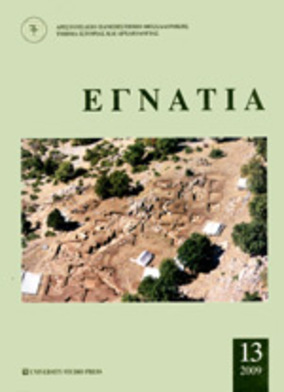Τα υδατοκορεσμένα ξύλα από το νεολιθικό λιμναίο οικισμό στο Δισπηλιό Καστοριάς
Part of : Εγνατία ; No.12, 2008, pages 65-85
Issue:
Pages:
65-85
Parallel Title:
The waterlogged wodden material from the Neolithic lakeside settlement at Dispilio, Kastoria
Section Title:
Αρχαιολογία
Author:
Abstract:
Wood, as an archaeological find, embodies all the stages ofthe chaine-opératoire, whichtransforms it from a natural product (ecofact) into a finished cultural product (artifact) andallows us to associate each ofits stages to more than one aspects ofhuman life (man’s ecologicalconsciousness, technological capacity or economic decision-making level). The multidimensionalexploitation oftimber is being clearly reflected in the abundance ofwoodenobjects found in waterlogged - anaerobic (considerable elucidation or exclusion ofthe availableoxygen, which prohibits the development or the survival oforganisms such as insect andfungi) deposits in an impressively good condition. Excavation in such wet sites has shed lighton uses oftimber only glimpsed at in dry sites, not only in relation to architecture, but alsoin the construction of means oftransportation, oftrackways and platforms, of agriculturaland hunting tools, ofthe domestic toolkit, as well as a means for the ritual expression ofpastsocieties (figurines).Excavation at Dispilio has revealed wooden objects (vertical piles and horizontal timber)which were used mostly in the construction ofwhat appears to have been pile-framed houseserected on raised wooden platforms inside or just by the Kastoria lake. The wooden materialincluded also natural roundwood (brushwood and twigs), as well as woodchips, indicatingthat most ofthe woodworking was being performed inside the habitation area, even thoughthe material’s random distribution has made it impossible for us to detect specific woodworkingareas.The study ofthe toolmarks preserved on the timbers’ surface shows the application ofchopping for the transformation ofthe tree-trunks edges into pointed ends ofvarious types.Furthermore, there is evidence for the application of all the other common Neolithic woodworkingtechniques, the hewing and hollowing ofthe upper part of vertical piles for the fittingofhorizontal timbers on them, as well as the splitting oftrunks into rectangular boards.The tools used for chopping appear to have been small-sized and concave-edged groundstone axes and adzes, and it is highly possible (according to experimental and ethnographicstudies and archaeological evidence from other sites) that wooden wedges and mallets, flintblades and probably bone tools were used for the splitting and the hollowing ofthe timbersrespectively.The prevalence ofjuniper, according to the tree-species identification results, followed bypine, fir and oak, among the tree-species ofthe timbers at Dispilio shows, on one hand, thatthis Neolithic community was well-aware ofthe properties and morphological characteristicsof each tree-species and put them accordingly to the most appropriate use. For example,the prevalence ofjuniper in the vertical piles can be explained by the fact that juniper is resistantto water decay in wet conditions, while strong and suitable for constructions and thebearing of heavy loads. On the other hand, the identification of a variety oftree-species shows that the community ofDispilio used to select wood from various forest zones, not only close to the settlement but also from higher altitudes.
Subject:
Subject (LC):
Notes:
Περιέχει εικόνες και γραφήματα




